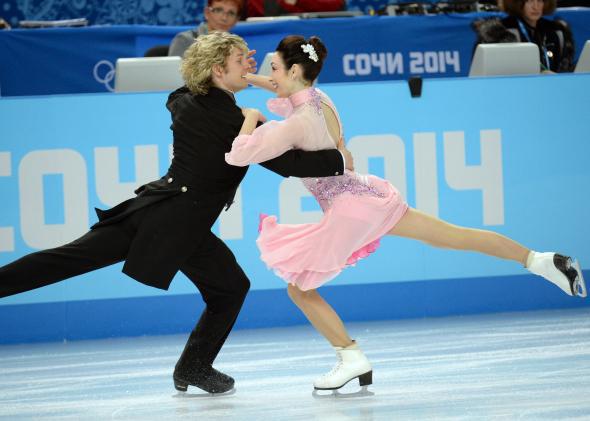In the ice dance competition in Sochi, men and women from around the world glided around the rink in skirts and tuxes, prancing and preening for gold. In the pairs competition, too, the composition of every team from every nation was exactly the same: one man and one woman. The movie Blades of Glory—in which Will Ferrell teams up with another male skater, played by Jon Heder, to compete against mixed pairs in the World Winter Sport Games—imagines a world in which on-ice gender norms aren’t so rigidly enforced. Could Olympic skaters work the same angle? Are same-sex pairs allowed in the Olympic ice dancing and pair skating competitions?
No. The rules of the International Skating Union, the sport’s governing body, are bluntly heteronormative. Rule 302, which governs pair skating, declares, “The composition of a pair must be one Lady and one Man.” Rule 303, which controls ice dance, says, “The composition of an Ice Dance Couple must be one Lady and one Man.”
The restrictions don’t stop there. Regulations about the types of lifts and throws permitted in the pairs events are extraordinarily exacting, not only regarding things like hand positions and how long lifts must be held but also about who does the lifting, holding, and throwing. (The “Man” must lift, hold, and throw the “Lady.”) Skating’s policing of gender expression extends even to the clothes the athletes wear on the ice. As a recent Newsweek story pointed out, “Men in ice dance cannot wear sleeveless costumes; women must wear skirts, and while the skirts can have slits, ‘ladies dress must not give the effect of excessive nudity.’”
Traditionally, teams in both pairs skating and ice dancing have been rewarded by the judges for choreography that suggests the couple is involved in a hot heterosexual romance. (That’s one reason sibling pairings often seem a little off somehow.) It’s a very old-fashioned straight romance, though, with strict roles for each gender. The man must project strength (those throws and lifts) and protection (keeping a partner’s head millimeters above the cold, hard ice during the death spiral) while the woman must submit stoically to her partner’s desire to boost her above his shoulders or toss her across the rink.
When couples choose not to emphasize a love connection, they tend to fall back on gallantry. While describing the free dance program skated by Tessa Virtue and Scott Moir of Canada on Monday, commentator Johnny Weir—an out gay man who frequently ran afoul of skating’s distaste for flamboyant male skaters—said: “It’s almost as if he is just running behind her to make sure that she’s always OK. He puts the jacket down on the puddle, he opens the door for her. It’s just very gentlemanly and sweet.” (Along these lines, I have a piece of unsolicited advice for U.S. ice dancers Maia and Alex Shibutani: Since judges and audiences don’t want to see siblings flirting, choreograph a routine that casts Alex as a Secret Service agent protecting President Maia.)
If the Olympics leave you with an urge to see same-sex pairs on the ice, make plans to visit Cleveland and Akron, Ohio, this August. Although ISU-governed events insist on male/female pairings, same-sex couples compete in the quadrennial Gay Games. (As befits the Gay Games’ spirit of inclusion, the figure skating program includes three categories for mixed pairs as well as single and pairs events for women and men.) The path to Gay Games glory isn’t always smooth, however. In 1994, when professional skaters Jean-Pierre Martin and Mark Hird, who were not a romantic couple, tried to practice for the LGBTQ event at a rink in their hometown of Montreal, other users complained to the owner about the pair skating together; some even claimed (incorrectly, according to Martin) that they had been kissing. As Marjorie Garber observed in a chapter in the anthology Women on Ice: Feminist Responses to the Tonya Harding/Nancy Kerrigan Spectacle, “the rink owner had no other way to understand the phenomenon of these men skating together than as a romance.”
This is exactly what the Olympic judges and the ISU rules that govern them want spectators to believe. Beyond the cold confines of the ice rink, the majority of Americans accept that marriage is no longer the exclusive province of one man and one woman. It’s about time the skating authorities let go of their antiquated notion of what a romantic couple looks like.
